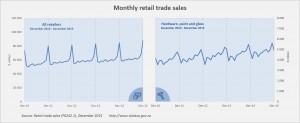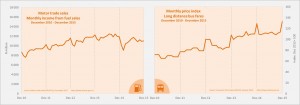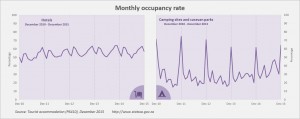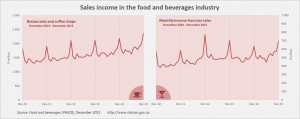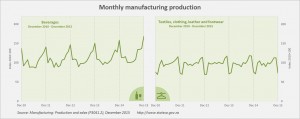
The economics of Christmas
The economics of Christmas: disrupting the normal
You are looking for a Christmas gift for Aunt Edna. As you browse the aisles, you think of how much you are looking forward to the trip down to the coast. December is an unusual time for the country economically. Monthly statistics on the economy clearly show how your actions, together with the actions of thousands of other holidaymakers, disrupt the normal.
Hardware stores left in the cold
You don’t shop for gifts that often, so you are relieved to find something special for Aunt Edna. As you head to the till, you notice how crowded the place is with other shoppers. December is bonanza time for bookstores and most other retailers.
One type of retailer misses out on all the excitement, however. Hardware stores experience a fall in sales during December and January1. After all, you’ve decided to hold off on that paint job in the spare room until you are back from holiday.
On the road: fuel sales and bus fares
It’s time to leave. After packing the car with luggage and the dog, your family hits the road for the journey to the coast. Aunt Edna will be happy to see the kids again. The highway is heavy with holiday traffic. Increased travel across the country drives up fuel sales in December2.
You overtake a bus, and briefly wonder how much a bus trip to the coast might cost. Seasonality also plays an important role in bus travel. Notice how long-distance bus fares rise over the festive period in the chart below, to only decrease again in January3?
Hotels quiet while camping sites thrive
Aunt Edna’s place is small. She is retired after all. So you’ve booked the family in holiday accommodation nearby. As you offload the kids, the dog and the luggage, you think of how lucky you were to get this timeshare. A hotel room would have been just too small.
Surprisingly, hotels experience the lowest occupancy rates in December4. At first glance, this might seem counterintuitive, until you consider that the main clientele of hotels throughout the year are corporate guests. Fewer business trips take place over the festive season.
Camping and caravan sites, however, experience a hive of activity over the same period. Occupancy rates often spike above 60% as their gates open to welcome the influx of holidaymakers.
Regaling in food and drink
You plan to visit Aunt Edna tomorrow. Right now the kids want to head to the beach. But first a bite to eat! Luckily, there is a takeaway close by. You’ve jettisoned the idea of cooking on holiday, anyway.
Other families have made the same decision. Statistics on income earned in the food and beverages industry show a spike in restaurant and coffee shop sales over the festive season, together with takeaway and bar sales5. Notice the peak in bar sales in December 2012?
Keeping well stocked with beverages is important to many a beach goer. Not only do bar sales peak in December, but as textile, food, wood, metal and other manufacturers take a break (after a very busy October and November), beverage manufacturers go full steam ahead, recording annual production peaks in December6.
So after having a quick lunch you soon find yourself sitting on the beach under an umbrella, enjoying a cold glass of orange juice as the kids play in the waves. This is the life. This is how going on holiday affects the economy.
By the way, Aunt Edna will like her book on economic statistics. Very much. It will help her sleep.
Oh, and if you’ve ever heard of ‘seasonally adjusted’ statistics and wondered what that could possibly mean, it’s really very easy: based on past patterns in the actual data, statisticians can remove all the seasonal dips and spikes that we’ve just been talking about, which leaves the underlying trend much easier to see and understand. So, to take an easy example, seasonally adjusted retail sales allow us to judge whether December was a good or bad month without the ‘economics of Christmas’. It turns out that although actual retail sales in December 2015 were much better than November 2015 (no surprise there), after removing the Christmas effect, December retail volumes were slightly lower than in November.
1 Click here for the Retail trade sales, December 2015 release.
2 Click here for the Motor trade sales, December 2015 release.
3 Click here for the Consumer Price Index, January 2016 release.
4 Click here for the Tourist accommodation, December 2015 release.
5 Click here for the Food and beverages, December 2015 release.
6 Click here for the Manufacturing: Production and sales, December 2015 release.
Photo: Rodger Bosch, http://www.mediaclubsouthafrica.com/


